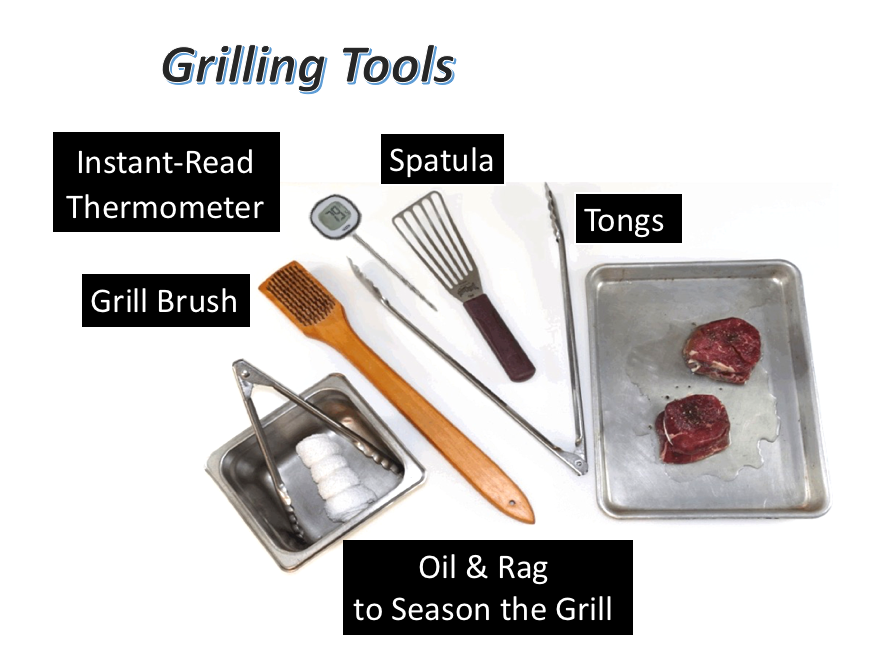Grilling & Broiling Techniques
Grilling and broiling use radiant heat at temperatures in excess of 500°F (260˚C). Although the terms are used interchangeably, grilling, by definition, uses a heat source from below, while broiling uses upper heat. Grilling over wood or charcoal produces the best flavor, but natural gas can also produce an acceptable product. Pan-grilling creates a grill effect, although it is not as flavorful as a true grill.
Grilling
Broiling
Pan Grilling
The intense heat used for grilling creates a Maillard Reaction through the rendering of fats and caramelization of the sugars in the proteins. Flavor development is further enhanced because the fats render and drip on the heat source.
What to Grill
Grilling and broiling are most suited for naturally tender items that need a relatively short cooking time, including steaks, chops, fish fillets, and shellfish. Hamburgers, sausages, and skewered foods, including vegetables like onions, tomatoes, mushrooms, and peppers, are also good candidates. Larger steaks and chops can be started on the grill and finished in an oven to prevent excessive charring and minimize bitter flavors. Whole fish or fillets can also be grilled in specially designed baskets or wood planks.
Grilled Fish
Grilled Vegetable Kabobs
Best Choice for Grilling: Beef, pork, veal, lamb, venison loin, rib, and tenderloin steaks and chops, burgers, skirt steak, flank steak, poultry breasts, Cornish hens, quail, squab, fish steaks (tuna, swordfish), small whole fish, shrimp, scallops, kabobs
Best Choice for Broiling: Fish steaks and fillets, lobster, shrimp, oysters, clams
Accompaniments: Compound butters, sauce condiments (chimichurri, chermoula, salsa), classic small French brown or white sauces, béarnaise and hollandaise variations
Meats
Seasoning – Liberally season with salt and pepper, or use a dry rub with garlic powder, onion powder, and red chili flakes. Rub lamb with fennel pollen or ground rosemary. Brush with a neutral oil (canola or soybean oil)
Heat Index: High to medium-high
Chicken & Other Poultry
Seasoning - Brine or marinade poultry, add complimentary spices, including sage, thyme, and lemon zest.
Brush with a neutral oil (canola or soybean oil)
Brush with a diluted barbecue sauce (apply towards the end of the cooking process); avoid sugary sauces, brines, and marinades – they will burn equicklyat high temperatures
Heat Index: Medium to medium-high heat
Grilled Clams
Seafood
Seasoning – Season with salt and pepper, fresh herbs like chives, tarragon, or parsley, or a dry rub like Cajun seasoning.
Brush with a neutral oil (canola or soybean oil)
Heat Index: Medium to medium-high heat is best for cooking all forms of seafood, from whole fish, to fillets or steaks, to clams and oysters, or shrimp and scallops on a skewer
Vegetables & Fruits
Whole corn in the husk, sliced squash or root vegetables, halved fruits like peaches or avocado.
Seasoning - Marinade or season & oil
Heat Index: Medium heat
Grilled Vegetables
Grilled Pears
Tools for Grilling and Broiling
Setting Up the Grill
Clean & Season
Pre-heat the grill 30-60 minutes before service. Clean the grill with a wire brush to remove excess carbon debris. Season the grill by brushing it with an oiled rag to seal the pores of the grate, making it less likely to stick when cooking.
Cook in the Zone
Set up zones on the grill to cook items at different temperatures and times
Depending on the size of the grill, you may have 2 or three zones
Grilling in Action
Place the items, presentation side down, using tongs, on the grill to be cooked.
Allow time for the item to cook and develop color and the characteristic grill marks; the item should naturally release from the grill if it has been appropriately seasoned.
Turn the item 90° with tongs to create a cross-hatch effect; use a spatula for fish fillets.
Flip the item and continue cooking; turn as needed
Use indirect heat after marking to finish at the desired temperature
Cover the product with a small pan to cook faster and reduce flare-ups
Checking for Doneness
Check the internal temperature; insert an instant-read thermometer into the center of the steak without touching the bone.
Resting Time
Remove from the grill when slightly undercooked to allow for carryover cooking.
Place on a tray or pan and keep warm
Rest for a few minutes to allow the juices to redistribute before carving.
Grilling Tips
For rare-cooked steaks, use high heat, for well-done steaks, use lower heat.
For rare steaks, use thicker cuts; for well-done steaks, use thinner cuts
For well-done steaks, mark the steak and finish in an oven















